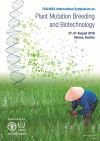Speaker
Description
Striga is an obligate hemi-parasitic weed species that attacks roots of major cereal crops such as sorghum, millet, maize and rice. In severe situations of Striga infestation, losses in crop yield may reach up to 90-100%. Forty percent of arable land in sub-Saharan Africa is infested with Striga with annual losses estimated up to 14 billion US$. For subsistence farmers, growing resistant varieties is one of the most viable control option. A Coordinated Research Project was launched by the IAEA in 2016 for mutation breeding of resistance to Striga in major cereal crops with the objective to develop screening protocols, generate genetic variability and optimize efficiency enhancing technologies to accelerate delivery of resistant varieties. We report in this presentation an overview of the progress made and the prospective. Simple, efficient and reliable screening protocols were optimized for field, glass-house and laboratory screening of Striga hermonthica and asiatica in upland rice and sorghum. These protocols were verified in more than one site in the participating countries and validated on M2 populations. A total of 82 and 47 putative resistant mutants were, so far, reported in upland rice and sorghum, respectively, by three of the participating countries in Africa (Burkina Faso, Madagascar and Sudan), and the PBGL. Field resistance in M4 of 20 upland rice and 6 maize lines from Madagascar are in verification and classification at PBGL using pot-phenotyping. Field performance of promising mutants will be evaluated across different environments and crosses will be made between stable mutants and their parents for allelism test, mechanism of resistance and to produce populations for development of molecular markers linked to the resistance. The technologies developed and the generated resistance to Striga together with the markers will enable wide adoption by member states for Striga management in vulnerable areas.

